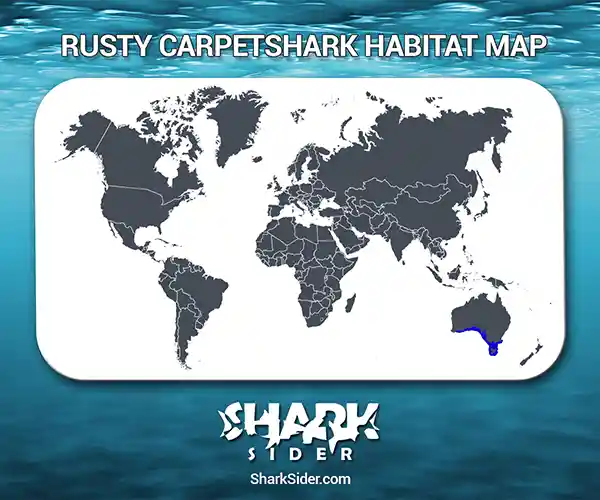The Rusty Carpetshark, named due to its distinctive mottled coloring, is a type of carpetshark endemic to Southern Australia. It is also known as the Tasmanian Spotted Catshark or the Tasmanian Carpetshark. McCulloch first described it in 1911 using a specimen caught in Victoria, Australia.
Rusty Carpetshark Scientific Classification |
|
| Kingdom | Animalia |
| Phylum | Chordata |
| Class | Chondrichthyes |
| Order | Orectolobiformes |
| Family | Parascylliidae |
| Genus | Parascyllium |
| Scientific name | P. ferrugineum |
Description
The females of this species are larger, growing to 75 cm (2.5 ft), while males reach 60 cm (2 ft). The maximum recorded length was 80 cm (2.6 ft).
They are grayish-brown with a faint collar around the neck and 6-7 dark bands or saddles over their body, fins, and tail. They have 3-4 rows of spots along the sides and fins, with specimens from Tasmania having denser spots. The mouth lies in front of their slit-like eyes, and the nose is grooved with barbells.
Their bodies are slender and long, with similar-sized, spineless dorsal fins. The first dorsal originates behind the pelvic fins and the second behind the anal fin.
Where do they live
Map Of The Rusty Carpetshark’s Habitat

This shark is native to the Eastern Indian Ocean, on the temperate southern Australian coast. It inhabits a variety of habitats in the regions of Victoria, Tasmania, and South Australia (31°S-45°S, 117°E-149°E). This bottom-dwelling species is found near rocks, river mouths, and algae or seagrass in the reefs. It lives at depths of 5-150 m (16-492 ft).
Behavior
Dietary
They mainly feed on crustaceans and bony fishes from the sea floor.
Reproductive
They follow an oviparous mode of reproduction, laying yellow egg cases with long, slender tendrils in summer. Newborn pups measure around 17 cm (6.9 in).
Predatory
They follow a nocturnal lifestyle, lying in rocky caves and ledges during the day, and hunting at night.
Adaptations
They share similar features with other sharks, such as a sharp sense of smell and vision, streamlined bodies, and pointed teeth.
Human interactions
They are caught as a part of the bycatch by trawlers. Some conservation measures, such as those in the Southern and Eastern Scalefish and Shark Fishery, undertaken by the Southeast and Southwest Commonwealth Marine Reserve Networks, have helped control their population.
The IUCN lists this species as “Least Concern” or “LC.”
